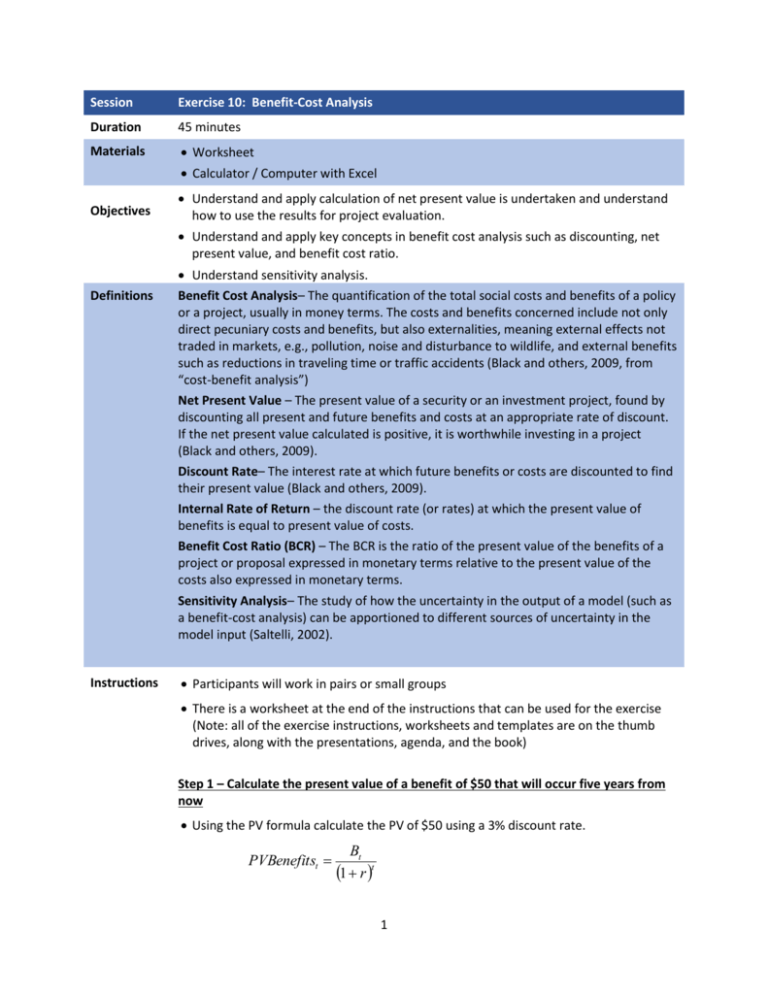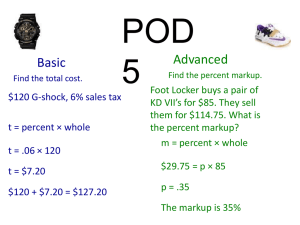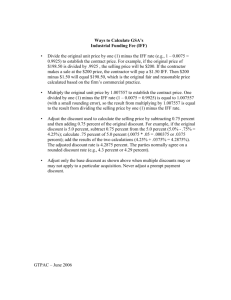Benefit-Cost Analysis
advertisement

Session Exercise 10: Benefit-Cost Analysis Duration 45 minutes Materials Worksheet Calculator / Computer with Excel Objectives Understand and apply calculation of net present value is undertaken and understand how to use the results for project evaluation. Understand and apply key concepts in benefit cost analysis such as discounting, net present value, and benefit cost ratio. Definitions Instructions Understand sensitivity analysis. Benefit Cost Analysis– The quantification of the total social costs and benefits of a policy or a project, usually in money terms. The costs and benefits concerned include not only direct pecuniary costs and benefits, but also externalities, meaning external effects not traded in markets, e.g., pollution, noise and disturbance to wildlife, and external benefits such as reductions in traveling time or traffic accidents (Black and others, 2009, from “cost-benefit analysis”) Net Present Value – The present value of a security or an investment project, found by discounting all present and future benefits and costs at an appropriate rate of discount. If the net present value calculated is positive, it is worthwhile investing in a project (Black and others, 2009). Discount Rate– The interest rate at which future benefits or costs are discounted to find their present value (Black and others, 2009). Internal Rate of Return – the discount rate (or rates) at which the present value of benefits is equal to present value of costs. Benefit Cost Ratio (BCR) – The BCR is the ratio of the present value of the benefits of a project or proposal expressed in monetary terms relative to the present value of the costs also expressed in monetary terms. Sensitivity Analysis– The study of how the uncertainty in the output of a model (such as a benefit-cost analysis) can be apportioned to different sources of uncertainty in the model input (Saltelli, 2002). Participants will work in pairs or small groups There is a worksheet at the end of the instructions that can be used for the exercise (Note: all of the exercise instructions, worksheets and templates are on the thumb drives, along with the presentations, agenda, and the book) Step 1 – Calculate the present value of a benefit of $50 that will occur five years from now Using the PV formula calculate the PV of $50 using a 3% discount rate. PVBenefitst Bt 1 r t 1 Step 2 – Calculate NPV for Project Using 0% Discount Rate The 2nd and 3rd columns show the “current” value benefits and costs for years 0 through 4. Using a 0% discount rate calculate the benefits and costs in each year, determine the total, the NPV, and the BCR. Step 3 – Calculate NPV for Project Using 5% Discount Rate Perform the same calculations in the same Example 2 table using a 5% rate of discount. You can either... 1. … calculate the discount factors and enter those in the shaded column first and then calculate each year’s present value of benefits and costs before summing them. 2. … or you can directly calculate the present values using the PV formula. 3. Then sum the PV benefits and costs and calculate the NPV and BCR. 4. What is the decision with respect to the project based on the NPV and BCR? Step 4 – Sensitivity Analysis 1 – Change in Discount Rate Using the table for Example 3 – repeat the steps using a 5% discount rate and a 12% discount rate. Is there a difference in the project decision based on the different discount rates? Step 5 – Sensitivity Analysis 2 – Change in Benefits and Costs (no money for O&M) In this sensiticity analysis we examine the impact of not continuing operations and maintenance after the initial investments. The initial costs are the same but then go to zero in years 2-4. The benefits start the same in Year 1 but then diminish to zero as the project deteriorates due to lack of maintenance. Using the table for Example 4 – repeat the steps using a 0% discount rate and a 5% discount rate for the flow of benefits and costs. Is there a difference in the project decision based on the different discount rates? 2 Worksheet Exercise 10: Benefit-Cost Analysis PVBenefitst Bt 1 r t PVCostst Ct 1 r t Example 1: For a Benefit of $50 (B=$50) that will occur 5 years from now (t=5) using a 3% discount rate (r=.03). PVBenefits5 50 50 $43.13 5 1 .03 1.1593 Discount Factor 1 1 0.8626 5 1.03 1.1593 PVBenefits5 50 x 0.8626 $43.13 Example 2: Basic Calculation of Present Values Project Benefits and Costs Year 0 1 2 3 4 Total Benefit 0 5 5 5 5 Cost 5 5 1 1 1 Discount Rate = 0.0% PV Benefit PV Cost NPV BCR 3 Discount Rate = 5.0% PV Benefit PV Cost NPV BCR Example 3: Impact of Different Discount Rates Project Benefits and Costs Year 0 1 2 3 4 Total Benefit 0 5 5 5 5 Cost 5 5 1 1 1 Discount Rate = 5.0% Benefit Cost NPV BCR Discount Rate = 12.0% Benefit Cost NPV BCR Example 4: BCA With No Money for O&M Project Benefits and Costs Year 0 1 2 3 4 Total Benefit 0 5 4 1 0 Cost 5 5 0 0 0 Discount Rate = 0.0% Benefit NPV BCR 4 Cost Discount Rate = 5.0% Benefit NPV BCR Cost








